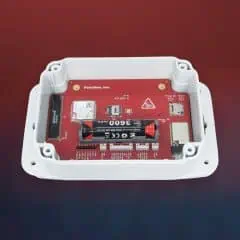More IP phone models supported for auto-provisioning
You can now offer your business customers an even wider range of IP phone models that support fast, automatic setup through auto-provisioning. The newly supported models are:
- Yealink SIP-T46S
- Polycom VVX411
- Polycom VVX410
- Polycom VVX250
To start using auto-provisioning for these models, you’ll need an active subscription to the corresponding Add-on Mart modules.
In addition to provisioning basic settings, such as SIP credentials, SIP proxy address, and codec preferences, PortaSwitch also supports self-provisioning of programmable phone keys for these phone models. This enables cloud PBX customers to use a self-care portal (either the PortaOne CloudPBX Self-Care Portal or a custom-built portal) to configure functions like call parking, BLF, or speed dialing for specific keys and apply the setup to multiple phones in one go. For Yealink SIP-T46S, PortaSwitch also lets customers self-provision corporate phone books.
This functionality – self-provisioning of both programmable phone keys and corporate phone books – is now also available for two other models already supported for auto-provisioning: the Yealink SIP-T46U and SIP-T43U.
What’s improved?
Easier onboarding of new customers
Attract more businesses by ensuring quick phone setup for the IP phone models they already use and prefer.
Find more details here.
Update faster: migrate customers first, xDRs later
When you update your system from one release to another (like from MR100 to MR115) with the Dual Version PortaSwitch solution, the customers, accounts, and their data are transferred from the old version to the new one. For large customers, e.g., those with thousands of accounts, the transferred data may include a massive number of xDRs (e.g., call or data usage records), which can result in lengthy processing and even the potential for noticeable service disruption.
Now, you can choose to postpone or even skip transferring xDRs during the migration of customers. This option is available for Dual Version “jumps” from MR100-6.
Example
Let’s say Owl Telecom is upgrading from MR100 to MR115 using Dual Version. On April 20, the MR100 database is copied to the new MR115 system. On May 4, Owl Telecom plans to move a large customer, ABC Company, to the new system.
Between April 20 and May 4, ABC Company’s users generate thousands of xDRs. To avoid delays and minimize downtime for ABC Company, Owl Telecom decides to transfer only the xDRs from the current billing period (May 1 to May 4) along with the customer data. This ensures accurate invoice generation for May and allows users to access their service usage history. The older xDRs from April 20–30 are transferred later, on May 15 – without any service disruptions – while ABC Company is already up and running on MR115.
What’s improved?
More flexible Dual Version migrations
Transfer large customers separately from their xDRs to avoid delays and keep downtime to a minimum.
Find more details here.
Fine-tune call queues with more precise time settings
Call center managers can now define call queue settings – such as average call duration, announcement interval, and maximum waiting time – with precision at the level of seconds rather than whole minutes. This enables more accurate and timely announcements for callers in the queue.
For example, if statistics are showing that the average call duration is 40 seconds, setting that exact value allows the system to calculate a more accurate estimated wait time for callers in the queue. Let’s say there are four callers ahead and only one agent – then the estimated wait time will be 40*4/1 = 160 seconds. For caller clarity, the system will still round up the wait time and announce it in minutes. So, if the calculated time is 160 seconds, the caller will hear, “Your estimated wait time is 3 minutes.”
Setting the announcements interval in smaller increments (for example, every 30 seconds) means callers get more timely updates about their place in the queue, helping to reduce uncertainty and frustration.
With maximum waiting time configurable in seconds, call centers can more precisely offer alternative actions – such as giving callers the option to leave a voicemail instead of waiting. For example, if callers tend to hang up after 170 seconds, the system can play an announcement with alternative actions at 160 seconds, rather than waiting for the next full minute.
This fine-grained control is available for custom self-care portals built with the PortaBilling API, and will soon be supported in the PortaOne CloudPBX Self-Care Portal.
What’s improved?
Better customer experience
Call centers can reduce the number of abandoned calls with more precise call queue settings.
Find more details here.
Visual indication for accounts with DID numbers
Admins can now quickly identify whether an account has an assigned DID number (used as the account ID or alias) directly from the account list. A corresponding icon, with a tooltip that reads “This account has a DID assigned,” clearly marks these accounts, eliminating the need to open each account’s details.
Example
Say an Owl Telecom admin is troubleshooting inbound call issues for their business customer, ABC Company. The admin opens ABC Company’s account list and can easily spot accounts that are externally reachable via a DID number, thanks to the corresponding icon.
What’s improved?
Easier administration
Save time troubleshooting and managing accounts with DID numbers.
Find more details here.
Better admin control when disabling invoicing
When an admin selects the “Do not create an invoice” option for a specific customer or customer class, new regular invoices will no longer be generated. However, since selecting this option means that no invoice template is set, it will also be impossible to approve or reissue invoices that are currently under review (for example, invoices may need to be reviewed before being sent to large customers when launching a new service). To prevent unexpected issues, a warning is now displayed in the admin web UI, alerting admins to this limitation. If invoicing still needs to be disabled, the admin can choose whether invoices under review should be automatically approved or voided.
What’s improved?
Easier administration
Prevent issues with invoices under review that may arise from disabling invoicing.
Find more details here.

















